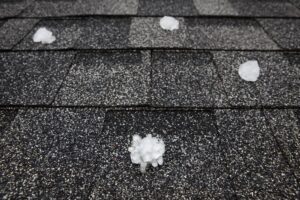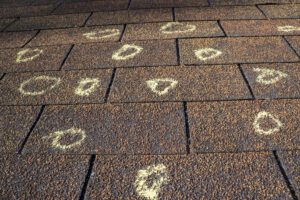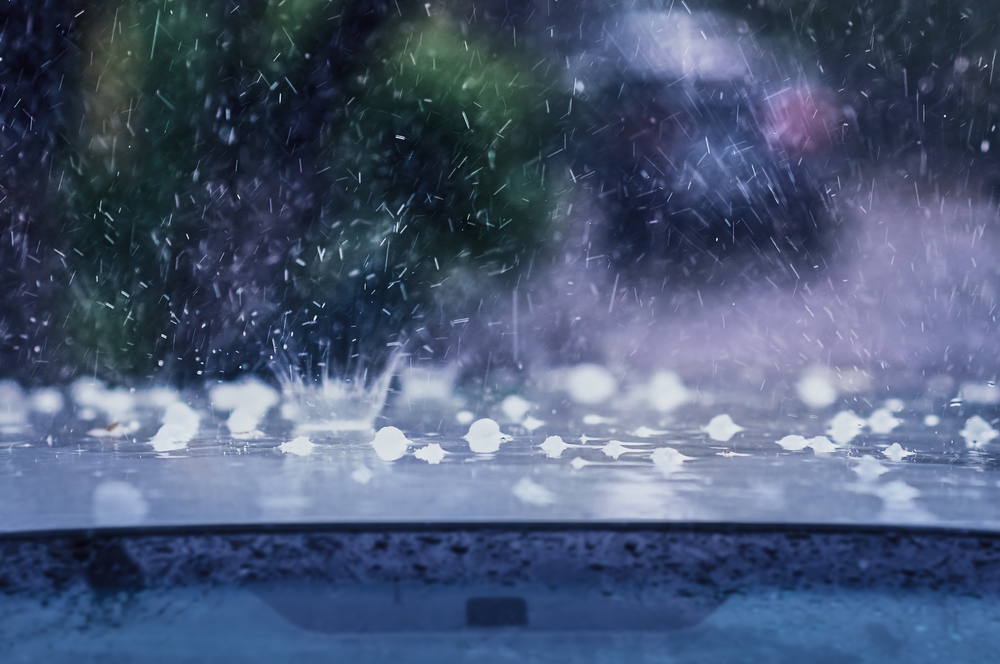Hail can be as small as a quarter or as large as a baseball. The bigger the hail, the more likely it is to cause issues.
Hail can be incredibly destructive to residential roofs, causing significant damage. Hail can cause dents in wood, broken shingles, paint damage, or even cracks in the siding. Read on to find out more about how hail affects your roof and what you can do about it.
What Does Hail Damage Looks Like on a Roof?
Hail damage doesn’t always look like what you’d expect. Read on to know all the tell-tale signs of hail damage.
Dented or Cracked Shingles
If you notice any dents, broken shingles, or even missing shingles, hail could have caused them. Damage shingles are bad for your roof because they can make it easier for water to leak into your roof and cause even more damage.
Missing Granules or Exposed Underlayment
Granules are the sandpapery covering on your shingles. Hail can cause the granules to come off. If this happens, it leaves the shingles exposed to the elements and can lead to quicker deterioration.
Tears or Punctures in Roofing Material
This is one of the issues that needs to be addressed the quickest. Punctures in your roofing material or tears mean it is less likely to protect your home from the elements or pests.
Damaged Gutters, Vents, or Flashing
Large hail can significantly damage gutters, vents, or flashing. This can lead to leaks and other water damage in your home.

How to Identify Roof Damage Without Getting on the Roof
If you don’t have a ladder or are worried about standing on a hail-damaged roof, there are a couple of things you can do to check roof damage from below your roof.
- An exterior visual inspection from ground level. If you notice any missing, damaged, or dented pieces from below, it’s time to call a pro to fix them. Don’t just focus on shingles either—look at gutters and siding too.
- Examination of your attic for signs of water or daylight. If your usually dark attic all of a sudden is looking a little lighter than usual, there could be a hole in your roof. If you notice dark or damp spots either on the floor or on the ceiling of your attic, there is probably water damage from a compromised roof.
- Use a pair of binoculars. It can be hard to see all the nitty-gritty details of shingles. Get a pair of binoculars to really see your shingles from the ground and make sure they are not damaged.
Other Parts of Your House Damaged from Hail
Your roof isn’t the only thing that can be damaged in a hail storm. Hail falls on many things, which means you’ll have to look out for damages all around your home.
Siding Damage
Your siding could be dented, cracked, or chipped because of hail.
Window and Door Damage
This one is relatively easy to spot, but the glass in your doors or windows could be cracked or shattered. This typically happens with car windshields, but it is also possible to happen to the glass in your home.
Exterior Fixtures
Gutters, downspouts, and vents can all be damaged from hail. See if they are cracked, missing, or also chipped.

Determining the Need for Roof Repair or Replacement
Knowing whether to replace or repair your roof isn’t always as straightforward as you might think. Here are a couple of factors to consider when evaluating the extent of hail damage and determining what your next steps should be:
- Age and condition of the roof. If your roof is over 20 years old, it should be replaced. Even if the hail damage is minor, it is in your best interest to get a new roof right then and there to avoid larger problems down the road.
- Severity and extent of damage. If there is minor damage, then all you’ll need is probably a simple repair. Minor damage includes damaged, torn, or missing asphalt shingles. Moderate damage—like roof damage that causes a leak—can still be repaired without needing an entire roof replacement. You can also opt for partial reroofing. If you have significant damage to your roof, like multiple holes or a giant one, then you may need an entire new roof. It is always best to speak to a certified roofing contractor so they can let you know what course of action you should take.
- Presence of underlying structural issues. Some structural issues would take more time and money in the long run to repair as opposed to simply getting a new roof.
- Cost-effectiveness of repair versus replacement. At the end of the day, these costs are different. Replacement is more expensive than repair—but continuous repairs over the years can eat away at your wallet. A replacement, although a hefty upfront cost, can pay itself off over the years of problem-free roofing and no random repairs being needed.
Consequences of Ignoring Damaged Shingles
Ignoring shingle damage from hail or otherwise can lead to serious issues, such as:
- Water infiltration and roof leaks
- Compromised structural integrity
- Accelerated deterioration and further damage
- Increased likelihood of mold or mildew growth
Insurance Coverage for Roof Damage
The insurance coverage you’ll get for your roof depends on the extent of the damage and the type of coverage you have. Some insurances don’t have coverage for entire roof replacements, but only repairs instead. If you have homeowners insurance and live in a place that tends to have inclement weather, then roof damage from different weather conditions is probably factored into your insurance.
No matter the type of insurance you have, be sure to document all damages and file your claim in a timely manner to ensure you get the maximum amount of compensation for the damage to your roof.
Need Help With Hail Damage on Your Roof?
If you’ve experienced a bad hail storm and your roof has hail damage, call the pros at Homefix. We’re ready to bring your home back to its pre-hail condition and ensure that your house’s roof and structure are sound.

